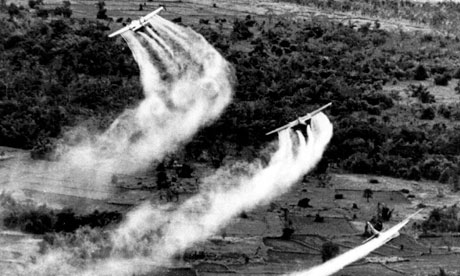Green Cost of Combat
Vietnam shows us the green cost of combat
The devastation wrought on Vietnam's landscape gives us a longer view of the environmental price of military adventurism
 US Air Force planes spray the defoliant chemical Agent Orange over dense vegetation in South Vietnam in 1966. Photograph: Associated Press
US Air Force planes spray the defoliant chemical Agent Orange over dense vegetation in South Vietnam in 1966. Photograph: Associated Press
The hills looked impressively green but the long dry season in the central Vietnamese highlands had stolen some brilliance from the trees. Nguyen Trinh a forestry department officer, said impassively "that was all areas (sic) where dioxin was used during the American war".
Those of us old enough to remember Agent Orange will know it became a chemical cause célèbre. To the Vietnamese it's known simply as "dioxin" in dubious honour of the byproduct that has produced such devastation among the people of Vietnam. It may, like swamp gas, be back to haunt the US, if the unfolding Agent Orange scandal in Ontario gathers momentum.
Years ago I visited factories littering a sandy emptiness in Vietnam's Dong Nai province. The inland area, strategically close to the Mekong Delta and Saigon, resembled an Ian McDonald multiverse, with industry segueing into what could be flat beach. A grim Vietnamese trade union official mourned: "This was forest and mangroves where people would fish. Now nothing – only steel and bricks." Dong Nai was one of the most seriously chemically effected areas with C-123s spraying the forest and mangroves with defoliants until 1970. The fish came back, fed by unstream tributaries, but the animals and plants are gone forever. The pragmatic Vietnamese turned the wasteland into a spreading industrial zone. {continued}
And from these present conflicts Veterans

US Air Force planes spray the defoliant chemical Agent Orange over dense vegetation in South Vietnam in 1966. Photograph: Associated Press


No comments:
Post a Comment